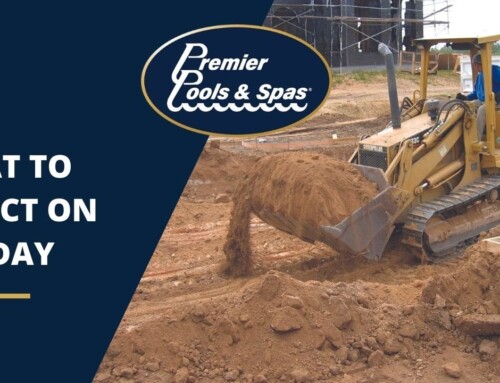
If your swimming pool’s water level seems to be a little low, you might have a pool leak. There are many things that can be causing this leak. Keep reading to learn if your swimming pool has a leak and what you can do to fix it.
A Pool Leak With Equipment On
If your pool is only leaking when the equipment is on, this could be a sign of a pressure-side return leak. When the filter pump is on, the plumbing that is on the pressure side after the pump is under pressure. This can cause small drips to spray gushers.
If this is happening, you will want to check the waste or the backwash line for water that is constantly running. Know that one inch of the water in your pool is equal to 500 gallons of water.
You will also want to peak at downhill of your pool for any underground leakage, soft or wet spots in the year, or on the side of your pool where plumbing is returning water to the swimming pool.
A Leaky Pool With The Equipment Off
If your pool is leaking when equipment is off, this usually means you have a suction-side leak. This could also mean there is a leak in the pipes that bring water from the pool. When the filter pump is on, the suction side plumbing is under vacuum.
This means that air can go into voids that are otherwise leaking. If you have a clear kid, you might notice air in the pump basket. Or you might see air bubbling out of the return lines, or that there is air built up inside the filter tank.
In these cases, you will want to use tape or a pencil to mark your pool’s water levels.
If Your Pool Is Always Leaking
If your pool is always leaking, know this doesn’t rule out plumbing leaks. Try to look at the shell of the pool for any tears in the vinyl or cracks in the plaster. You’ll want to look closer at the tile line and inside the skimmer or skimmers.
The leaks that are the most common, and can be fixed joining the separation between the concrete pool and plastic skimmer. This can be repaired with just pool putty.
If you see what looks like a crack on your pool, try to drop some test dye near it, with the pump off. See if the dye gets sucked into the crack.
Underwater lights can also cause leaks, especially the conduit runs from the junction box to the light niche. Here the opening of the conduit in the back of the light niche can be filled with pool putty. Or the problem can be fixed with a cord stopper.
Equipment Pad Leaks
You will want to take a close look at the pump, heater, filter, and valves. Check for moisture on the ground. Turn the pump off and on and look closely for any spraying water when the pump is off.
If there is a small drip or two, that is not the source of a leak. If water loss is noticeable in the pool, it will be more of a trickle than a leak.
Water Stabilization
If you notice that the water is stabilizing at a certain level, you could close the skimmer valve. This will let the water level drop to below the skimmer which will run the pump on the main drain.
If you notice that the water is still dropping, then you can rule out the skimmer. But there can always be more than one leak. When the water is stabilized at a certain level, do a dye test and carefully look around the pool at that level.
You want to look for small debris that may have been sucked into the void or crack. This will show you if there is a leak.
If the water stops at a wall step, pool light or wall fitting, get a closer look. Shut off the pump, plug the drain, skimmer and return lines with expansion plugs.
Wet Areas Around The Pool
You’ll want to to take a walk outside of your pool deck and between the pool and equipment pad. When doing this, check for any eroded areas or wet soil. Your pool should have a downward slope near the pool.
Walk down this hill and check if there is water weeping from the hillside. This way you can see where the water is going.
Vinyl Liner Pool
If you have a pool with a vinyl liner, know there are certain specific things you should look for. For example sinkholes under the liner than may have washed away.
You also want to keep an eye out for any separations or tears that are around all your fittings. This includes the returns, skimmer, cleaner line, pool lights, steps main drain, etc. Keep an eye on corners and steps where the liner could be stretched out more than normal.
If an animal fell into your pool, you might see tears in the form of claw markers right below your waterline. You might need to go underwater with a mask to see this small leak in your vinyl liner. When pool liners get old, they can easily develop pinholes.
There also can easily be more than one leak, but usually, it is just a gash in the liner. This gash is usually about one inch long which can be easily repaired with a vinyl patch kit or clear vinyl sealant.
Evaporation Rate
If you can’t tell what the evaporation rate is, you can get a bucket test to measure the evaporation. Simply put a bucket of water near the pool and mark both the pool water level and the water in the bucket. Wait at least 24 hours, then check the loss of water in both the bucket and pool.
If you notice the pool loses more water than the water in the bucket, then you have a pool leak.
Underground Plumbing Leaks
A lot of pools are not in underground plumbing. So it’s every pool owners fear that a backhoe can come in a rip the pool deck. This can happen, and a leak can occur at the pipe connector under the pool deck or below the skimmer, but you rarely need a backhoe for the repair.
You can determine if your pipes are leaking by shutting off the pump and plugging all of the lines. If your pool keeps on leaking, then you know it’s not the pipes. If it stops leaking, the plugs could be individually removed.
Some pools only leak when a pump is running. Once it’s narrowed down, a pool plumbing pressure test can be done to see what’s leaking.
You can use a stick or pressure testing rig to test individual lines and see that they are holding pressure. Experts are also able to put air into the pipe.
They will also use headphones and a giant stethoscope to hear if there is air escaping from the underground leak. This way they can draw an X on the year or deck to indicate to dig here.
Tile Leak
With concrete pools that have a traditional perimeter tile band at the waterline, you will most likely have a leak inside the skimmer. In rarer cases where the pool cracks behind the tile it will also crack the tile. Then water can leak through a crack at the top of the pool wall.
In this case, the crack can be cleaned, drained and then filled with EX Patch 22.
Leaking Cracks In The Pool
If you have a concrete pool with surface cracking, these pools usually don’t leak. But if there are larger and deeper cracks, this can cause leaking for sure. You will want to do a dye test to make sure.
Cracks can be filled with silicone, plaster mix, or putty to seal up small cracks. Large cracks that run across the pool and down the walls will need more prep. This involves a two-stage repair of injected sealant, then a coat of plaster mix.
Leaking Pool Skimmers
Almost all inground concrete pools will get leaking issues at the skimmer throat eventually. Contraction and expansion of the deck and pool move the skimmer a little which breaks the cementitious seal between the skimmer and pool wall.
There’s a seal on both sides of the front and bottom of the skimmer. If you turn the pump off, a dye test can tell if the water is being drawn into cracks around the front edge of the skimmer opening.
Pool putty is used as a temporary fix to seal up any leaking concrete skimmers. If you want a more permanent fix, you’ll want to chip out the plaster and replace it with an EZ Patch 1.
Fix Your Pool Today
Now that you know if you have a pool leak, you’ll want to hire a professional pool technician sooner rather than later. You will want an expert to handle any repairs, and you could make the leak worse by trying to fix it yourself. For more pool resources, check out more of our blog.



